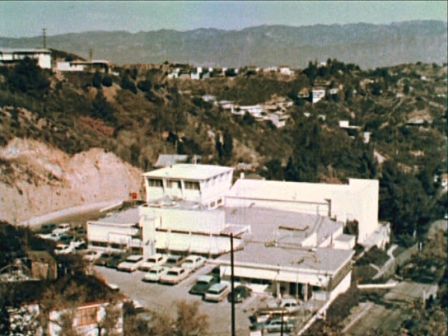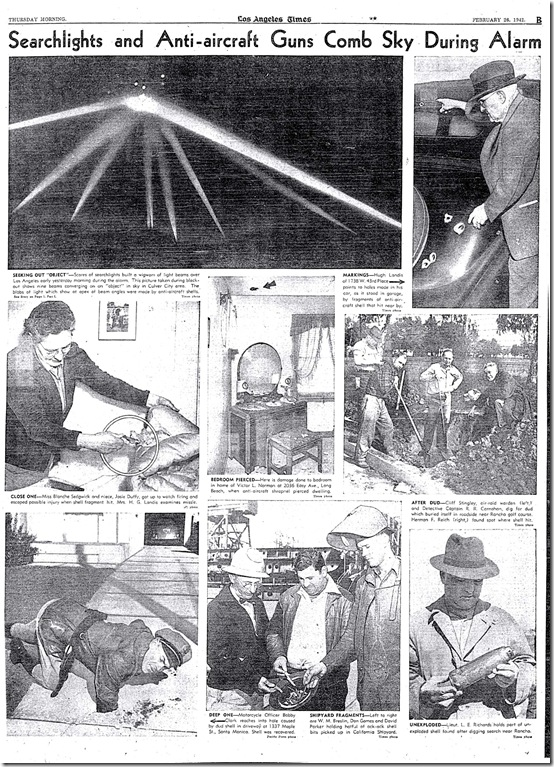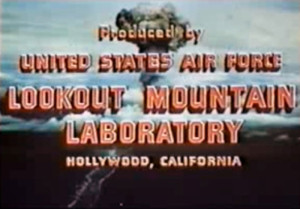 Two streets away from Robert A. Heinlein’s home at 8777 Lookout Mountain, on the other side of the hill, was the Lookout Mountain Air Force Station, at the end of another winding road above Laurel Canyon.
Two streets away from Robert A. Heinlein’s home at 8777 Lookout Mountain, on the other side of the hill, was the Lookout Mountain Air Force Station, at the end of another winding road above Laurel Canyon.
Histories say the facility was originally built in 1941 as a WWII air defense center that coordinated radar installations on nearby mountaintops. The permanent facility may date to 1943, when it was named the Los Angeles Flight Control Center. After WWII it was repurposed as a secret film studio for documenting atomic bomb tests.
However the site was first used, the Heinleins just missed its “baptism of fire” in February 1942 — the notorious Battle of Los Angeles – having moved to the east coast a few weeks earlier to get involved in war work.
Fear of a Japanese attack on Los Angeles mounted following Pearl Harbor. On Christmas Eve 1941, a Japanese submarine torpedoed an American ship in the Catalina Channel. On February 23 a submarine shelled an aviation fuel tank near Santa Barbara. And it was known some Japanese submarines carried aircraft.
In the early hours of February 25 radar picked up an unidentified target 120 miles west of Los Angeles – over the ocean – and tracked it to within a few miles of the coast. At 2:15 a.m. batteries were put on alert. The object vanished, however, the information center was soon flooded with reports of enemy planes. When a balloon carrying a red flare was seen over Santa Monica four batteries of antiaircraft artillery opened fire and “the air over Los Angeles erupted like a volcano.” More than 1,400 rounds were fired in a little over an hour. Shrapnel damaged houses and cars up to ten miles away and newspapers carried stories of close calls and about unexploded ordnance discovered in people’s neighborhoods.
Witnesses’ claims to have sighted strange slow-moving aircraft helped make the incident a popular topic of discussion among UFO-ologists after the war, who also closely studied the LA Times photo supposedly showing a target illuminated by searchlights.
Long after the war, journalist Matt Weinstock interviewed someone who believed he knew the ultimate cause of the “battle,” a man who had served in an Army squad that set up radar installations. Quoted on the Great Los Angeles Air Raid of 1942 site, he said:
“Early in the war things were pretty scary and the Army was setting up coastal defenses. At one of the new radar stations near Santa Monica, the crew tried in vain to arrange for some planes to fly by so that they could test the system. As no one could spare the planes at the time, they hit upon a novel way to test the radar. One of the guys bought a bag of nickel balloons and then filled them with hydrogen, attached metal wires, and let them go. Catching the offshore breeze, the balloons had the desired effect of showing up on the screens, proving the equipment was working. But after traveling a good distance offshore and to the south, the nightly onshore breeze started to push the balloons back towards the coastal cities. The coastal radar’s picked up the metal wires and the searchlights swung automatically on the targets, looking on the screens as aircraft heading for the city. The ACK-ACK started firing and the rest was history.”
And the LA Times debunked its own photo in 2011, with a reporter demonstrating that the picture had been doctored, many features having been painted in —
“Like lethal firecrackers, the anti-aircraft blasted above…” These are blobs of paint. The vertical break in the emulsion is where the print was folded for storage. The horizontal line is a crop mark.
Yes, the object in the center – which some have speculated is a flying saucer – is nothing but paint.
The Lookout Mountain Air Force Station’s other claim to fame only became known when its work was declassified a few years ago.
During the Cold War it was turned into the production headquarters for a unit assigned to film and photograph nuclear weapons tests. Expanded in 1953 into a 100,000-square-foot facility on a 2.5 acre site and surrounded by an electrified security fence, the studio consisted of one large sound stage, a film laboratory, two screening rooms, four editing rooms, an animation and still photo department, sound mixing studio, and numerous climate controlled film vaults.
In addition to military personnel, Lookout Mountain studio retained more than 250 producers, directors and cameramen recruited from MGM, Warner Brothers and RKO Pictures, all cleared to access top secret and restricted data and sworn to secrecy regarding activities at the studio.
Their field work was dangerous. A 2010 New York Times article about the unit begins —
They risked their lives to capture on film hundreds of blinding flashes, rising fireballs and mushroom clouds.
The blast from one detonation hurled a man and his camera into a ditch. When he got up, a second wave knocked him down again.
Then there was radiation.
While many of the scientists who made atom bombs during the cold war became famous, the men who filmed what happened when those bombs were detonated made up a secret corps.
Their existence and the nature of their work has emerged from the shadows only since the federal government began a concerted effort to declassify their films about a dozen years ago.
One of the last underground nuclear tests covered by Lookout Mountain crews was in June 1967. Between 1946 and 1969, Lookout Mountain studio produced more than 6,500 films for the Atomic Energy Commission and other government agencies.
The property was eventually decommissioned and sold off. It’s now a private residence, purchased not long ago by actor Jared Leto (Dallas Buyers Club) for $5 million.
Discover more from File 770
Subscribe to get the latest posts to your email.




100,000 sqft for $5mill – not bad. Wonder if he is going to use the sound studios for indi films. Be a good location to make cheesy SF movies about invading aliens.
Let us salute Brian Williams, a Lego enthusiast, who became fascinated by How to Photograph an Atomic Bomb— a book about Lookout Mountain Laboratories. He re-created the bomb-lensmen in a whimsical yet impressive Lego diorama.
I especially like his meticulous re-creation of specialized 1950s camera equipment used by the Lookout Mountain team.